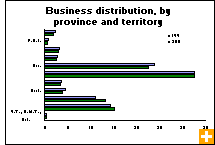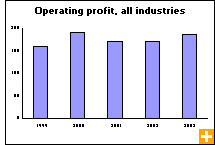Common menu bar links
Business enterprises
Archived Content
Information identified as archived is provided for reference, research or recordkeeping purposes. It is not subject to the Government of Canada Web Standards and has not been altered or updated since it was archived. Please contact us to request a format other than those available.
From the neighbourhood corner store to the leading TSX 500 multinational corporation, business enterprises provide Canadian consumers with the products and services they require. Family businesses, franchises, co-operatives, not-for-profit companies, virtual storefronts-all of these enterprises and many more share in the vibrant, diverse nature of Canada's business community.
In 2001, roughly one million businesses were operating in Canada, with more than one-half located in Ontario or Quebec. British Columbia and Alberta accounted for another one-quarter of all Canadian businesses. More than 9 out of 10 firms were businesses with 20 or fewer employees. And though businesses with more than 500 workers comprised only 0.2% of the total, they employed more than 42% of the Canadian work force. From 1991 to 2001, these proportions remained stable, even after the recession of the early 1990s and the technology boom a few years later.
A decade of business growth
 From 1991 to 2001, the overall number of firms grew only 9%, much slower
than the 22% growth rate seen over the previous seven years. On average,
140,500 firms were established each year from 1991 and 2001, whereas 132,000
ceased operations. Firms with 100 to 499 employees experienced the strongest
growth in number, at 29%. Of all firms created during the 1990s, one
in four closed their doors within the first two years, one in three survived
five years or more, and only one in five were still in operation 10 years
on.
From 1991 to 2001, the overall number of firms grew only 9%, much slower
than the 22% growth rate seen over the previous seven years. On average,
140,500 firms were established each year from 1991 and 2001, whereas 132,000
ceased operations. Firms with 100 to 499 employees experienced the strongest
growth in number, at 29%. Of all firms created during the 1990s, one
in four closed their doors within the first two years, one in three survived
five years or more, and only one in five were still in operation 10 years
on.
Alberta led business growth from 1991 to 2001, with 31% of the new firms. British Columbia and Ontario followed with 15% and 9% of new firms, respectively. Most of this growth occurred in the services sector, where the number of businesses increased 13%. In the goods-producing sector, the number of businesses edged up just 1%.
As for business failures, the number declaring bankruptcy has steadily declined almost every year since 1998. By 2004, business bankruptcies across Canada had dropped 25% from 1998 levels to about 8,100 cases. Businesses in the construction, retail trade, accommodation and food service industries were the most likely enterprises to go bankrupt.
Across all industries, Canadian corporations earned operating profits of $187.5 billion in 2003, up 10% over 2002 and 17% over 1999. Growth in 2003 was the strongest in three years. In fact, except for air transportation, all industries recorded operating profits. The three most profitable industries in 2003 were banking, oil and gas extraction and utilities. Canada's banking and insurance companies alone accounted for more than one-quarter of total corporate profits.
Higher profits generating more tax dollars
 As profits rise, so too do corporate taxes owed to government. Corporate
taxes payable rose to $40 billion in 2003, an increase of 13.8% from the
previous year. The portion owed to the federal government amounted to $27.8
billion, while the provinces claimed $12.2 billion.
As profits rise, so too do corporate taxes owed to government. Corporate
taxes payable rose to $40 billion in 2003, an increase of 13.8% from the
previous year. The portion owed to the federal government amounted to $27.8
billion, while the provinces claimed $12.2 billion.
Small businesses represent a big part of the Canadian economy. From 1993 to 2003, businesses with fewer than 50 employees, including the self-employed, accounted for about one-quarter of Canada's gross domestic product-about $243 billion in 2003. Small enterprises are also major players in our labour market, employing 49% of the work force.
The smallest of businesses-the self-employed-represented 15% of all workers each year from 2001 to 2004. Since there were fewer private sector employment opportunities during the recessions of 1982−1983 and 1991−1993, more Canadians chose to start their own businesses, and self-employment grew sharply. The highest percentage increase occurred in 1983, when self-employment soared 167% over the previous year. Self-employed workers include those with incorporated or unincorporated business that may or may not use paid help.
How do smaller businesses affect job creation?
 Recently, there's been considerable interest in how small and medium-sized
businesses affect job creation. Unfortunately, their impact is unclear. From
1994 to 2004, there were six years in which businesses with fewer than 100
employees made the greatest contribution to job creation; the other four
years were split between medium-sized and large businesses. But since these
data come from a period of economic expansion, the contribution of smaller
businesses to job creation during a recession might turn out to be quite
different.
Recently, there's been considerable interest in how small and medium-sized
businesses affect job creation. Unfortunately, their impact is unclear. From
1994 to 2004, there were six years in which businesses with fewer than 100
employees made the greatest contribution to job creation; the other four
years were split between medium-sized and large businesses. But since these
data come from a period of economic expansion, the contribution of smaller
businesses to job creation during a recession might turn out to be quite
different.
For a fifth consecutive year in 2004, Canadian companies' online sales over the Internet grew substantially. The private sector's online sales increased nearly 50% to $26.4 billion. Although the rate of growth and the value of online sales are significant, such sales still only represent a tiny fraction (1%) of the private sector's operating revenues-giving Canadian e-commerce plenty of room to grow.
So far, selling online has been concentrated in large firms, and only about 7% of all private companies engaged in it in 2004. In addition, the majority of e‑commerce sales are business-to-business in nature, rather than to individual consumers. In 2004, business-to-business electronic transactions amounted to $19.8 billion, representing about 75% of total e-commerce sales by private firms.
Two sectors with very high online sales, wholesale trade and manufacturing, are especially dedicated to business-to-business transactions. In 2004, 94% of online sales made by the manufacturing sector were between businesses, as were 84% of online sales made by firms in wholesale trade.
In contrast, retail trade obtained 85% of its nearly $3 billion in online sales in 2004 from business-to-consumer transactions. However, online sales represented only 0.8% of total retail sales in 2004.


